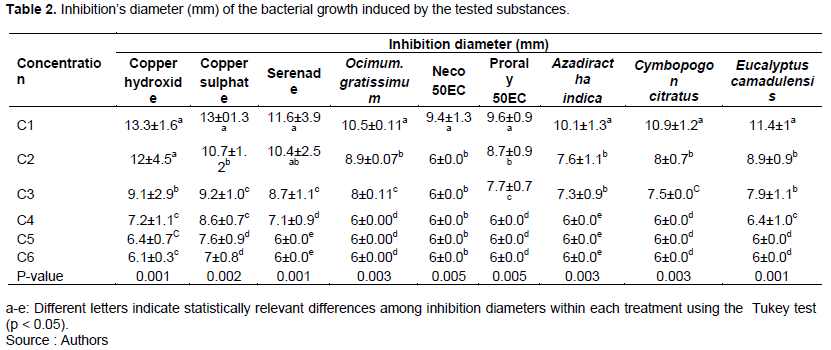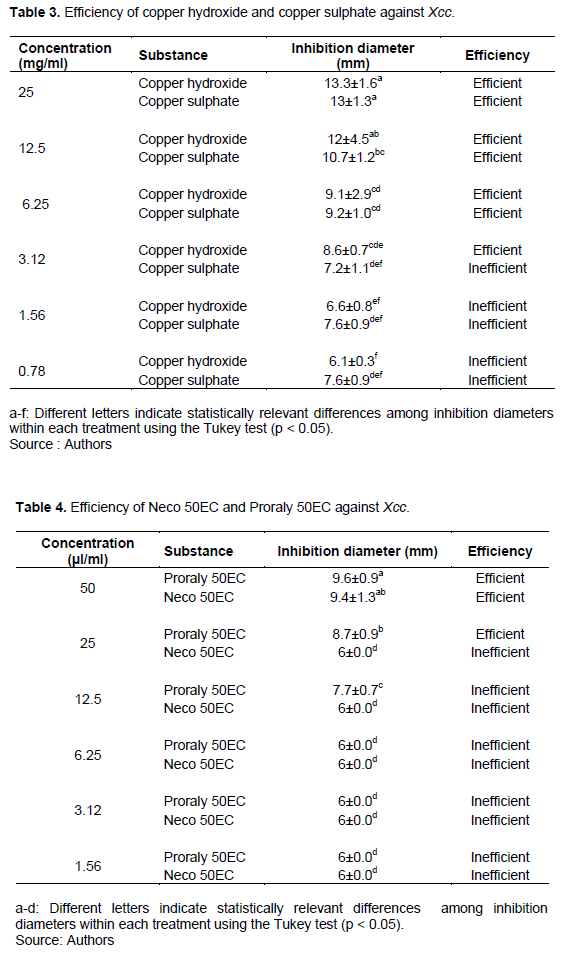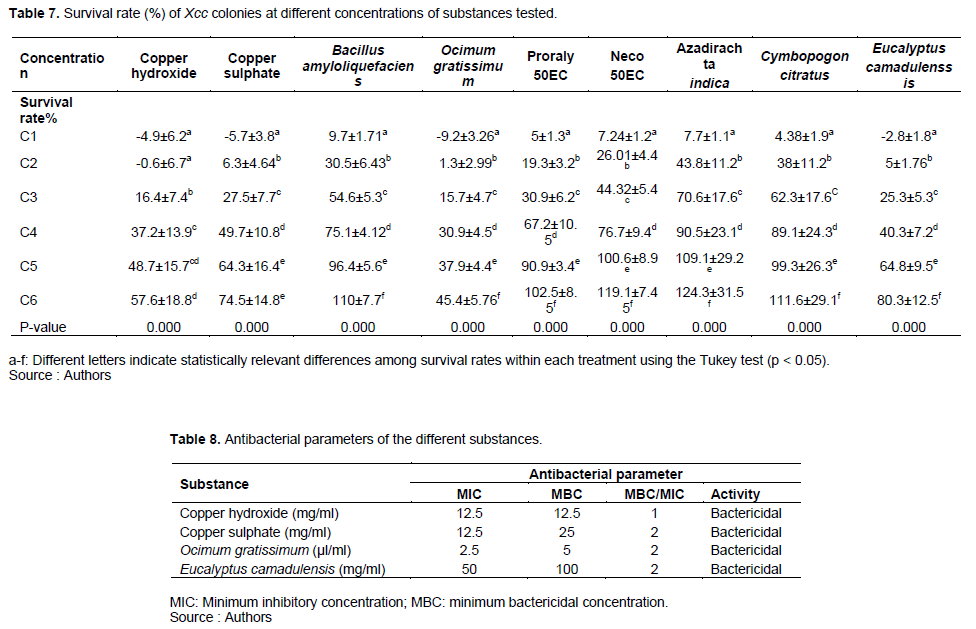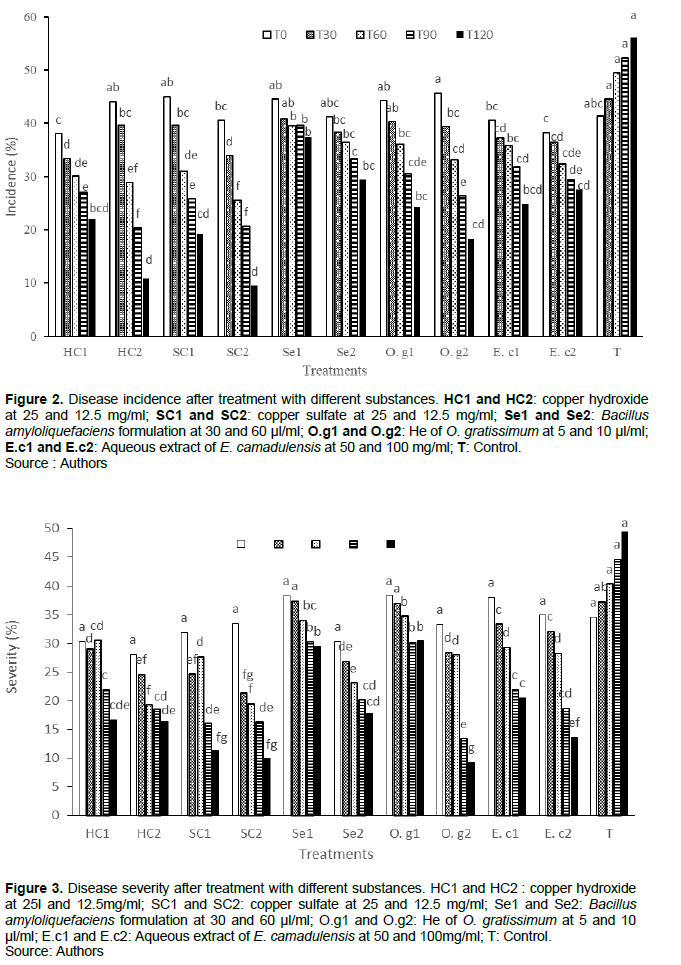Full Length Research Paper
ABSTRACT
Citrus bacterial canker (CBC) threatens citrus fruit production in Burkina Faso due to the lack of effective control methods. In this study, the antimicrobial effect of copper hydroxide and sulphate, the biopesticide from Bacillus amyloliquefaciens, the essential oil of Ocimum gratissimum and aqueous extracts of Eucalyptus camadulensis, Azadirachta indica and Cymbopogon citratus were tested in vitro and in vivo against Xanthomonas cirri pv. citri (Hasse) (Xcc890) strain from Burkina Faso. The dilution method in solid medium and macro-method dilution in liquid medium were, respectively used in order to determine the minimum bactericidal concentration (MBC) and the minimum inhibitory concentration (MIC). Hydroxide and sulphate copper tested at 25 mg/ml induced 13 mm in diameter of inhibition zone, followed by B. amyloliquefaciens at 25 µl/ml (11.6±3.9 mm). O. gratissimum induced 10.5 ± 0.11 mm of inhibition zone at 5 µl/ml. Aqueous extract of E. camadulensis at 100 mg/ml induced 11.4 ± 1 mm of inhibition diameter. Based on MBC/MIC ratio, copper hydroxide and sulphate, O. gratissimum and E. camadulensis have a bactericidal effect in vitro. In vivo test, copper products at 25 mg/ml and O. gratissimum at 10 µl/ml were the most effective and significantly reduced the CBC incidence. These substances can be evaluated under natural conditions in order to determine their effectiveness against CBC.
Key words: Citrus species, citrus bacterial canker, Xanthomonas citri pv. citri, antibacterial activity, substances.
INTRODUCTION
Citrus bacterial canker (CBC) caused by Xanthomonas citri pv. citri (Xcc) represents the most devastating bacterial disease on citrus production through the world (Salifou and Bounou, 2020). The disease causes defoliation, fruit cankers, a premature fall of fruit and a general withering of trees (Gottwald et al., 2002; CABI, 2019). There are no highly efficient strategies for controlling CBC disease. In Burkina Faso, CBC was reported on all commercial citrus cultivars in the provinces of Comoé, Houet and Kénédougou (Juhasz et al., 2013). In endemic areas, the quarantine and eradication are the major means of control against Xcc (OEPP/CABI, 1990). However, the use of windbreaks, destruction of infected branches and spraying of copper-based products during periods of susceptibility, can reduce the severity of the disease (Civerolo, 1984; Behlau, 2021).Indeed, copper-based products, despite their effectiveness (Stall et al., 1980; Idrissou-Touré et al., 2017), have an adverse effect on human and environmental health (Villeneuve, 2008; Damien et al., 2017). In addition, their repetitive and uncontrolled use causes resistance phenomenon in pathogens.
In order to prevent major damage caused by CBC, alternative less harmful tools have been extensively studied in recent years (Oliveira et al., 2021; Raveau, 2020). For example, several studies have shown that many plants from the West African flora have an enormous biocidal potential (toxic, repellent, anti-appetizing) against a broad spectrum of pests. They can be used in the form of aqueous extracts or essential oils (Saha et al., 2013; Zombré et al., 2015). In Burkina Faso, despite the high prevalence of CBC and the resulting crop losses, no means of control, including the use of copper-based products, have been deployed. Wonni et al. (2016) showed that aqueous extract and essential oil of Eucalyptus camaldulensis have an antibacterial activity in vitro test against both pathovars of Xanthomonas oryzae. The results of Rabbee et al. (2021) showed that ethyl acetate extract from Bacillus velezensis, have antibacterial activity against Xcc wildtype strains, in contrast to Bacillus amyloliquefaciens strains which had no antibacterial activity.
In order to promote an effective control of Xcc, the present study aimed to evaluate in vitro and in vivo, the antibacterial activity of some chemical, biological substances, plant aqueous extracts, and essential oils.
MATERIALS AND METHODS
Bacterial strain and inoculum’s preparation
Strain Xcc 890 was isolated in 2020 from samples of tangelo species ((Citrus reticulata × Citrus paradisi) from the citrus orchard of the locality of Kodeni which is located in the commune of Bobo-Dioulasso (Figure 1), on the Bobo-Banfora axis (National Road No. 7). The geographic coordinates of the site are 11°7?40.5372? North Latitude, 4°19?6.34332? West Longitude. The inoculum was prepared from a 24 h bacterial culture. It was suspended in 5 ml of 0.85% physiological NaCl solution and adjusted to 108 bacterium/ml using a spectrophotometer at A600nm. The different activities were carried out in the bacteriology laboratory of INERA/FARAKOBA.
Substances tested
Five types of substances were tested. They were (i) Chemicals; sulphate and hydroxide copper, (ii) plant aqueous extracts; of Azadirachta indica (A.) JUSS, Cymbopogon citratus (D.C.) STAFF, and E. camadulensis DEHNH, (iii) essential oils; Ocimum gratissimum LINNE, (iv) biological substance derived from B. amyloliquefaciens supplied by BAYER company and (v) formulations based on essential oils that were Neco 50EC and Proraly 50EC from Côte d’Ivoire.
Preparation of aqueous plant extracts
The aqueous extracts of leaves of A. indica (A.) JUSS., C. citratus (D.C.) STAFF and E. camadulensis DEHNH, were prepared according to the method described by Guédé-Guina et al. (1996).
The leaves were collected at the Farako-Ba station with coordinates Longitude 4°20’ West, Latitude 11°6' North and an altitude of 405 m. The leaves were firstly dried in the shade for two weeks, and then powdered using a mortar. The powders were macerated in the proportion of 1 g of powder/1 ml of distilled water and the suspension was kept for 24 h. The mixture was then, centrifuged at 4000 rpm for 10 min and the supernatant was sterilized in order to remove contaminants. The final substrate was stored in the refrigerator for its use.
Concentration range
Six concentrations per substance were used in this study. They were prepared by the method of double dilution in according to a geometric progression of ½ reason (Toty et al., 2013) from a maximal concentration (C1) to a minimal concentration (C6) (Table 1).

Efficiency test in vitro
It was performed using the standard disc or antibiogram method (Abo-Elyousr and Asran, 2009). Bacterial suspension of 40 μl at 108 CFU/ml was spread uniformly over the entire surface of the LPGA solid medium (LPGA for 1 L: Yeast 7 g, Peptone 7 g, Glucose 7 g, Agar 18 g) contained in Petri dishes. After drying, sterile blotting paper discs of 6 mm diameters were placed and inoculated with 10 μl of each substance. A negative control was inoculated with sterile distilled water. Petri dishes were firstly incubated for 1 h at room temperature, and then at 30°C in inverted position into incubator. After 72 h incubation, the diameters of inhibition (ID) zones were measured.
The efficacy of each substance was determined based on the criteria of Ponce et al. (2003) as follows: (i) ineffective: ID <8 mm, (ii) effective: 9 mm < ID <14 mm; (iii) very effective: 15 mm <ID <19 mm, and (iv) highly effective: ID > 20 mm.
Determination of antibacterial parameters
It was carried out using the technique of microdilution in nutrient liquid. This technique consisted of inoculate in a standardized inoculum, and decrease concentrations of the tested substances. For this, a series of seven test tubes, each containing 3 ml of LPGA nutrient liquid, were inoculated with 50 μl of bacteria inoculum at 108 colonies/ml, and then 50 μl of each substance according to the concentrations defined in Table 1 except for the control tube. The tubes were placed at 28°C under shaking for 24 h, and then at 28°C for 72 h in a bacteriological incubator. Three parameters were assessed in the following.
Bacterial growth (Tsurvey)
It was determined to measure the optical density (DO) of each tube using spectrophotometer before and after incubation and to calculate with the formula used by Moroh et al. (2008).
Tsurvey (x) = (Ti -Tf) / (Tit –Tft),
where Ti: initial DO; Tf: final DO; Tit: initial DO of control without substance; Tft: final DO of control without substance.
Minimal inhibitory concentration (MIC) and minimal bactericidal concentration (MBC)
They were determined to assess the bactericidal or bacteriostatic effect (Berche et al., 1991) of each substance by calculating the MBC/MIC ratio as follows:
(1) bactericidal if MBC/MIC ≤ 2;
(2) bacteriostatic if MBC/MIC > 2
In vivo test
Young plants of the tangelo species with leaves infected by CBC, from nurseries in the city of Orodara, were used under greenhouse conditions, to test the effective concentrations of the substances which were found to be effective in vitro. Therefore, copper hydroxide and sulfate (25 and 12.5 mg/ml), HE of O. gratissimum (5 and 10 µl/ml), the aqueous extract of E. camadulensis (50 and 100 mg/ml), and B. amyloliquefaciens formulation (30 and 60 µl/ml) were tested every 15 days.
Before foliar treatment with the substances, we counted (i) the number of symptomatic leaves per plant, (ii) the proportion of canker on each symptomatic leaf per plant, and (iii) the number of symptomatic leaves of the plant. These data were used to calculate the foliar incidence and severity of CBC according to the following formulae defined respectively by Idroussou-Touré et al. (2017) and Mayee and Datar (1986).
Disease incidence (%) = (NSL/NTL) × 100
where NSL: the number of symptomatic leaves; NTL: the number of total leaves.
The severity was evaluated using the scale of Lakshmi et al. (2011).
Severity = Addition of numerical notation × 100 / Number of examined unit × Maximal note.
Statistical analysis
The analysis of variance and Tukey's test were carried out with the Minitab18 software in order to compare the effectiveness of the substances used at different doses in vitro and in vivo, but also to compare the variations between MIC and BMC.
RESULTS
Sensitivity of the Xcc strain to the tested substances
All the tested substances showed an inhibitory effect at the different concentrations used, with a very remarkable effect of copper hydroxide at 12.5 mg/ml, inducing 13.3 ± 1.6 mm of inhibition diameter (Table 2). In general, the inhibition diameter was proportional to the concentration of each tested substance. In fact, the highest inhibition diameters were obtained with the maximum concentrations (C1).

Efficiency of the different tested concentrations
Tables 3 to 6 show the efficiency of the antibacterial activity of each substance in terms of the tested concentrations. The products based on copper were efficient from the concentration of 3.12 mg/ml for copper hydroxide and 6.25 mg/ml for copper sulphate (Table 3). The antibacterial activities of Proraly 50EC and Neco 50EC were efficient, respectively from 25 and 50 µl/ml concentrations (Table 4). Below these doses, they became inefficient. Furthermore, the antibacterial activity of the formulation based on B. amyloliquefaciens was efficient to the concentration of 6.25 µl/ml, whereas the essential oil of O. gratissimum was efficient from 1.5 µl/ml (Table 5). The efficiency of plant aqueous extracts was very variable according to the vegetal species. So, the aqueous extracts of C. citratus and E. camadulensis were efficient to the concentration of 50 mg/ml, whereas that of A. indica was efficient from 100 mg/ml (Table 6).


Survival rate of Xcc
The survival rates of Xcc at the different tested concentrations were inversely proportional to the increase of the concentration of each substance (Table 7). Indeed, the lowest rate of survival (-9.2±3.26%) was registered with O. gratissimum at 5 µl/ml. However, the highest rate of survival (124.32±31.54%) was registered with the aqueous extract of A. indica at 6.25 mg/ml.
Characteristics of the tested substances
The different values of Minimal Inhibitory Concentrations (MIC) and Minimal Bactericidal Concentrations (MBC) are shown in Table 8. Referring to survival rates, MBC/MIC ratios ≤ 2 were obtained with the copper sulphate, essential oil of O. gratissimum and aqueous extract of E. camadulensis confirming their antibacterial properties. However, we were unable to determine the MIC and MBC of B. amyloliquefaciens, A. indica, C. citratus and Proraly 50 EC due to their opacity.

Effect of treatments on the incidence and severity of citrus bacterial canker
The results showed that the averages of incidence and severity of CBC significantly differed among the treated substances. We noted a significant decrease of the incidence and severity on the treated plants compared to untreated controls, which incidence progressed from 41.32 to 56.12% after 120 days of observation (Figures 2 and 3). The C2 concentrations tested were the most effective. Analysis showed that the strongest disease reduction rates were obtained with copper hydroxide and sulfate at 12.5 mg/ml. However, with O. gratissimum at 10 µl/ml, we recorded a reduction in disease without significant difference with chemical products.

DISCUSSION
Through this study, we evaluated the antibacterial activity of the diverse substances in vitro and in vivo on the growth of X. citri pv. citri. The two chemical products based on copper at 25 mg/ml, were the most active with the high inhibition diameters. Furthermore, the aqueous extract of A. indica, C. citratus and E. camadulensis and essential oils of O. gratissimum were each active inducing an inhibition diameter superior to 10 mm at the maximal tested concentrations. The lowest inhibition diameters were obtained with Neco 50EC and Proraly 50EC.
According to MBC/MIC ratios of copper hydroxide (12.5 mg/ml), copper sulphate (25 mg/ml), O. gratissimum and E. camadulensis (50 mg/ml), the results showed that these substances have antibacterial properties.
For in vivo tests, the results showed that chemical products based on copper and the essential oil of O. gratissimum were the most effective, when they were used in foliar treatment each two week intervals.
In fact, the antibacterial action of copper hydroxide and copper sulphate in vitro and in vivo has been demonstrated by several studies (Girard, 2004; Idrissou-Touré et al., 2020; Behlau et al., 2021). However, some authors claimed that the use of copper can induce resistance to pathogens (Giraud et al., 2007; Villeneuve, 2008; Damien et al., 2017), create environmental pollution and copper accumulation in soils (Alva et al., 1995).
To attenuate the harmful effect of copper, some authors recommended its use in combination with mancozeb (Roberts et al., 2008; Fayette et al., 2012) or other biological components such as B. subtilis (Provost et al., 2012).
Studies have shown that the essential oil of O. gratissimum contains components such as thymol over 43%, gamma-terpinene 18.77% and para-cymene 6.77% (Soro et al., 2011), which would give it a bactericidal activity. Thus, thymol was one of the components of essential oils that are the most active against pathogens (Ajjouri et al., 2008).
The results confirmed those finding of Kpodekon et al. (2013) that demonstrated that the MICs and CMBs of O. gratissimum would be respectively between 6.10-3 and 144.10-3 mg/ml. In addition, Zombré et al. (2015) have shown that O. gratissimum was effective against bacterial blight of cashew and mango caused by X. citri pv. mangiferaindica. Saha et al. (2013) have also reported the antibacterial activity of O. gratissimum against Gram negative bacteria.
The effectiveness of aqueous plant extracts of A. indica, C. citratus and E. camadulensis has been proven in numerous studies, especially against fungi of the Fusarium genus (Dao, 2013; Tiendrebeogo, 2011).
As for the results obtained in the study with the biopesticide, the component of B. amyloliquefaciens would be the active molecule. Chen et al. (2009) reported that B. amyloliquefaciens produces various antibiotics which confer antibacterial activity. Roberts et al. (2008) and Ibrahim et al. (2016) have shown its efficacy on numerous species of Xanthomonas, Pseudomonas and Erwinia. Ye et al. (2016) reported that in vivo treatment with the combination of copper products and B. subtilis formulations reduced the incidence of CBC by only 19%, whereas untreated plants had 43%.
CONCLUSION
All the substances tested showed antibacterial properties against Xcc and their efficacy changes with concentration. The copper products were the most effective followed by the essential oil of O. gratissimum, the aqueous extracts of E. camadulensis and the substance formulation of B. amyloliquefaciens respectively. These substances were induced reductions of the incidence and severity of CBC, when applied at certain concentrations at two weeks intervals. Therefore, they can be tested in the field to determine their effectiveness.
CONFLICT OF INTERESTS
The authors have not declared any conflict of interests.
REFERENCES
|
Abo-Elyousr KAM, Asran MR (2009). Antibacterial activity of certain plant extracts against bacterial wilt of tomato. Archives of Phytopathology and Plant Protection 42(6):573-578. |
|
|
Ajjouri ME, Satrani B, Ghanmi M, Aafi A, Farah A, Rahouti M, Amarti F, Aberchane M (2008). Activité antifongique des huiles essentielles de Thymus bleicherianus Pomel et Thymus capitatus (L.) Hoffm. Link contre les champignons de pourriture du bois d'œuvre. Base 12(4):345-351. |
|
|
Alva AK, Graham JH, Anderson CA (1995). Soil pH and copper effects on young 'Hamlin' orange trees. Soil Science Society America Journal 59(2):481-487. |
|
|
Behlau F, Lanza FE, da Silva Scapin M, Scandelai LHM, Silva Junior GJ (2021). Spray volume and rate based on the tree row volume for a sustainable use of copper in the control of citrus canker. Plant Disease 105(1):183-192. |
|
|
Berche P, Gaillard JL, Simonet M (1991). Les bactéries des infections humaines", Éditeur : Flammarion. Médecine & Sciences. 660 p. |
|
|
CABI (2019). Invasive species compendium Xanthomonas citri (citrus canker). Disponible sur. Avalable at: |
|
|
Chen XH, Koumoutsi A, Scholz R, Schneider K, Vater J, Sussmuth R, Piel J, Borriss R (2009). Genome analysis of Bacillus amyloliquefaciens FZB42 reveals its potential for biocontrol of plant pathogens. Journal Biotechnology 140(1-2):27-37. |
|
|
Civerolo EL (1984). Bacterial canker disease of citrus (Xanthomonas campestris). Journal of the Rio Grande Valley Horticultural Society 37:127-146. |
|
|
Damien R, Tribot N, Boyer C, Terville M, Boyer K, Javegny S, Roux-Cuvelier M, Pruvost O, Moreau A, Chabirand A, Vernière C (2017). First report of copper resistant Xanthomonas citri pv. citri pathotype A causing Asiatic citrus canker in Réunion France. Plant Disease 101(3):503. |
|
|
Dao K (2013). Étude de la variabilité de Fusarium verticilloides (Sacc.) Nirenberg isolé des semences paysannes de maïs au Burkina Faso et recherche de méthodes de lutte alternatives basées sur les extraits de plantes in vitro. Mémoire du Diplôme d'Etude Approfondie, Institut du Développement Rural, Université Polytechnique de Bobo-Dioulasso, Burkina Faso 54p. |
|
|
Fayette J, Roberts PD, Pernezny KL, Jones JB (2012). The role of cymoxanil and famoxadone in the management of bacterial spot on tomato and pepper and bacterial leaf spot on lettuce. Crop Protection 31:107-112. |
|
|
Girard H (2004). Le cuivre: origines. Usages et différentes formes. Conférence Journées techniques Nationales Viticulture Biologique Avignon. Editions ITAB. Pp. 73-89. |
|
|
Giraud M, Prunet JP, Chevallier A, Ramain S (2007). La bactériose du noyer. Evolution des populations de Xanthomonas en verger. Infos Ctifl 230:38-42. |
|
|
Gottwald TR, Graham JH, Schubert TS (2002). Citrus canker: the pathogen and its impact. Plant Health Progress 3(1):15. |
|
|
Guédé-Guina F, Vangah-Manda M, Harounad D, Bahi C (1996). Potencies of MISCA a plant source concentrate against fungi. Journal of Ethnopharmacology 14(2):45-53. |
|
|
Idrissou-Touré M, Sirikou R, Bello S, Oussou F, Dossoumou MEEA (2017). Efficacité de l'hydroxyde de cuivre contre la nervation noire du chou (Brassica oleracea L.) causée par la bactérie Xanthomonas campestris pv. campestris. Agronomie Africaine 29(2):149-157. |
|
|
Ibrahim YE, Saleh AA, El_Komy MH, Al_Saleh MA (2016). Bacillus subtilis QST 713, copper hydroxide, and their tank mixes for control of bacterial citrus canker in Saudi Arabia. Journal of Citrus Pathology 3(1):1-6. |
|
|
Juhasz CC, Leduc A, Vernière C, Pruvost O, Wonni I, Ouedraogo L (2013). First report of Xanthomonas citri pv. citri Causing Asiatic Citrus Canker in Burkina Faso. Plant Disease 97(12):1653. |
|
|
Kpodekon MT, Boko CK, Mainil JG, Farougou S, Sessou P, Yehouenou B, Gbenou, J, Duprez JN, Bardiau M (2013). Composition chimique et test d'efficacité in vitro des huiles essentielles extraites de feuilles fraîches du basilic commun (Ocimum basilicum) et du basilic tropical (Ocimum gratissimum) sur Salmonella enterica sérotype Oakland et Salmonella enterica sérotype Legon. Journal de la Société Ouest-Africaine de Chimie 35:41-48. |
|
|
Mayee CD, Datar VV (1986). Phytopathometry. Department of Plant Pathology, Marathwada Agricultural University, Parbhani. Technical Bulletin 3:110. |
|
|
Moroh JLA, Bahi C, Dje K, Loukou YG, Guede-Guina F (2008). Étude de l'activité antibactérienne de l'extrait acétatique (EAC) de Morinda morindoides (Baker) milne-redheat (rubiaceae) sur la croissance in-vitro des souches d'Escherichia coli. Bulletin de la Société Royale des Sciences de Liège 77:44-61. |
|
|
OEPP/CABI (1990). Fiche informative sur les organismes de quarantaine. Xanthomonas axoponodis pv. Citri. Préparé par le CABI et l'OEPP pour l'UE sous Contrat 90/39900. |
|
|
Oliveira Filho JGD, da Cruz Silva G, de Aguiar AC, Cipriano L, de Azeredo HMC, Bogusz Junior S, Ferreira MD (2021). Chemical composition and antifungal activity of essential oils and their combinations against Botrytis cinerea in strawberries. Journal of Food Measurement and Characterization 15(2):1815-1825. |
|
|
Ponce AG, Fritz R, del Valle C, Roura SI (2003). Antibacterial activity of essential oils on the native microflora of organic Swiss chard. Society of Food Science and Technology 36(7):679-684. |
|
|
Provost C, Guerra N, Caron L (2012). Evaluation de nouveaux agents bactéricides contre deux maladies bactériennes des tomates de champ. Programme de Soutien à l'Innovation Horticole. Québec, Canada 3 p. |
|
|
Rabbee MF, Ahmed CR, Roy A, Chowdhury R, Kubra K, Banik A, Chowdhury MMH, Baek KH (2021). Promesses thérapeutiques des plantes médicinales au Bangladesh et de leurs composés bioactifs contre les ulcères et les maladies inflammatoires. Plantes 10(7):1348. |
|
|
Raveau R, Fontaine J, Lounès-Hadj Sahraoui A (2020). Essential Oils as Potential Alternative Biocontrol Products against Plant Pathogens and Weeds: A Review. Foods 9(3):365. |
|
|
Roberts PD, Momol MT, Ritchie L, Olson SM, Jones JB, Balogh B (2008). Evaluation of spray programs containing famoxadone plus cymoxanil. acibenzolar-S-methyl and Bacillus amyloliquefaciens compared to copper sprays for management of bacterial spot-on tomato. Crop Protection 27:1519-1526. |
|
|
Saha S, Dhar TD, Sengupta C, Ghosh P (2013). Biological activities of essential oils and methanol extracts of five Ocimum Species against pathogenic bacteria. Czeh Journal of Food Sciences 31(2):194-202. |
|
|
Salifou A, Bounou BI (2020). Attaque du chancre bactérien des agrumes sur des pieds de tangelos de pamplemoussier et de citronnier dans la commune de Youri (département de Say), VegNote. Volume 1: N°1, Clinique des plantes. Bioengineering and Agri-business consulting. Disponible sur. Available at: |
|
|
Soro S, Abo K, Kone D, Coffi K, Kouadio JY, Ake S (2011). Comparaison de l'efficacité antifongique de l'huile essentielle d'Ocimum gratissimum L. et du fongicide de synthèse mancozebe contre le mycopathogene tellurique, Fusarium oxysporum f. Sp. Radicis-lycopersici en cultures de tomate (Lycopersicon esculentum Mill.) Sous abri en côte d'ivoire. Agronomie Africaine 23(1):43-52. |
|
|
Stall RE, Miller JW, Marco GM, Echenique BIC (1980). Population dynamics of Xanthomonas citri causing cancer of citrus in Argentina. Proceedings of the Florida State, Horticultural Society 93:10-14. |
|
|
Tiendrebeogo A (2011). Étude de l'efficacité des extraits aqueux de plantes locales (Edipta alba L. Cymbopogon citratus (D. C.) Stapf. Agavae sisalana Perr. et Lippia multiflora (Moldenke) contre les principaux champignons seminicoles du riz. Mémoire d'Ingénieur du Développement Rural. Institut du Développement Rural. Université Polytechnique de Bobo Dioulasso. Burkina Faso 67 p. |
|
|
Toty AA, Guessennd N, Bahi C, Kra AM, Otokore DA, Dosso M (2013). Evaluation in vitro de l'activité antibactérienne de l'extrait aqueux de l'écorce de tronc de Harungana madagascariensis sur la croissance de souches multi-résistantes. Bulletin de la Société Royale des Sciences de Liège 82:12-21. |
|
|
Villeneuve C (2008). Lutte aux bactéries et résistance au cuivre dans le poivron et la tomate. Conférence des journées horticoles de Saint Remy. Document Agri Réseau 7 p. |
|
|
Wonni I, Ouedraogo SL, Ouedraogo I, Sanogo L (2016). Antibacterial activity of extracts of three aromatiplants from Burkina Faso against rice pathogen, Xanthomanas oryzae. African Journal of Microbiology Research 10(20):681-686. |
|
|
Zombré C, Sankara BC, Ouédraogo SL, Wonni I, Pruvost O, Boyer C, Vernière C, Adandonon A, Vasyssière JF, Ahohuendo BC (2015). First report of Xanthomonas citrus pv.mangiferaeindicae causing Mango bacterial canker on Mangifera indica L. in Benin. Plant Disease 99(12):1854. |
|
Copyright © 2024 Author(s) retain the copyright of this article.
This article is published under the terms of the Creative Commons Attribution License 4.0